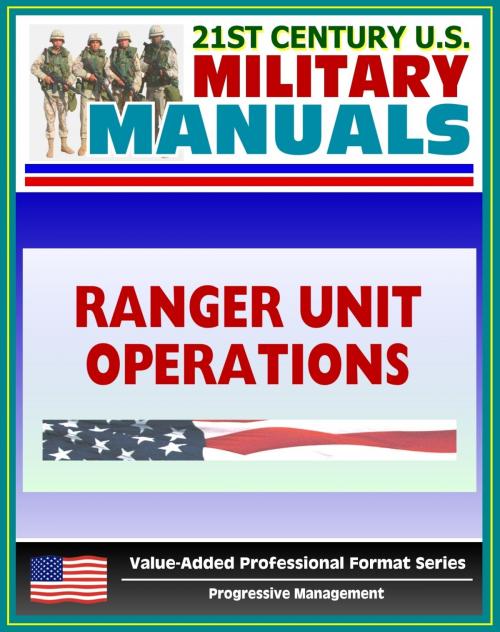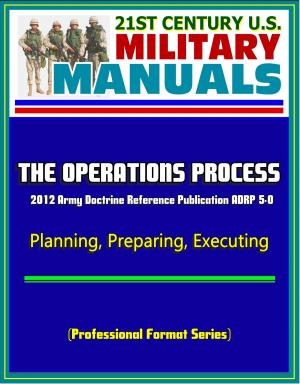21st Century U.S. Military Manuals: Ranger Unit Operations - FM 7-85 (Value-Added Professional Format Series)
Nonfiction, History, Military, Social & Cultural Studies, Political Science| Author: | Progressive Management | ISBN: | 9781466098015 |
| Publisher: | Progressive Management | Publication: | September 9, 2011 |
| Imprint: | Smashwords Edition | Language: | English |
| Author: | Progressive Management |
| ISBN: | 9781466098015 |
| Publisher: | Progressive Management |
| Publication: | September 9, 2011 |
| Imprint: | Smashwords Edition |
| Language: | English |
Part of our value-added professional format series, the Ranger Unit Operations
Field Manual (FM 7-85) covers the operations of US Army Ranger units. This FM has been converted for accurate flowing-text e-book format reproduction.
In the preface, it states:
"This publication contains doctrinal guidelines for the employment and training of ranger units. The intended audience is intermediate and higher level commanders, staffs of those headquarters, and newly assigned officers and NCOs of the ranger regiment. It is to be used with all other published US doctrine concerning NBC operations and the climatic or geographic influences on combat. The fundamentals apply to the employment of ranger units on worldwide operations and across the spectrum of conflict from low to high intensity warfare. This includes all aspects of the integrated battlefield: nuclear, biological, and chemical. It is not intended to apply to the employment of long-range reconnaissance patrol (LRRP) companies, even though such units carry the designation "ranger." These LRRP companies, as well as the long-range surveillance company (LRSC) (corps level) and the long-range surveillance detachment (LRSD) (division level), are organized, trained, and equipped for long-range reconnaissance in enemy territory. The scope of this publication addresses the mission, organization, equipment, capabilities, limitations, planning, training, operations, and logistical support of ranger units. It describes how the ranger regiment and its subordinate battalions train, receive taskings, plan missions, task-organize, deploy, and integrate supporting elements to perform the mission. Once in combat, the ranger regiment maneuvers to accomplish the mission in the manner of other light infantry units. Ranger units make full use of published light infantry doctrinal guidance."
Some highlights of the contents:
"The ranger regiment is a major component of the US Army's special operations forces. It is a unique light infantry unit tasked to conduct special military operations in support of national policies and objectives. These operations require highly trained, well-disciplined units capable of employment in any environment, either alone or in concert with other military forces. Within this publication, the term ranger force describes any size force consisting mainly of members of the ranger regiment and led by a member of the ranger regiment's chain of command. A ranger force may be a TOE unit or it may be a specially organized task force for a specific mission. The mission of the ranger regiment is to plan and conduct special military operations. These operations are conducted by specially trained, equipped, and organized forces against strategic or tactical targets in pursuit of national military, political, economic, or psychological objectives. They may support conventional military operations or they may be performed independently when conventional forces cannot be used."
This manual is produced by Headquarters, US Army Training and Doctrine Command (TRADOC).
As a bonus, this reproduction includes FM-1, The Army Field Manual, a capstone manual containing the vision for the Army - sold separately for $5.99. FM 1 establishes the fundamental principles for employing Landpower. The most important of these are the Army's operational concept and the fundamentals that support it. They form the foundation for all Army doctrine. All Soldiers should understand and internalize them. FM 1 describes the American profession of arms, the Army's place in it, and what it means to be a professional Soldier.
This is a privately authored news service and educational publication of Progressive Management.
Part of our value-added professional format series, the Ranger Unit Operations
Field Manual (FM 7-85) covers the operations of US Army Ranger units. This FM has been converted for accurate flowing-text e-book format reproduction.
In the preface, it states:
"This publication contains doctrinal guidelines for the employment and training of ranger units. The intended audience is intermediate and higher level commanders, staffs of those headquarters, and newly assigned officers and NCOs of the ranger regiment. It is to be used with all other published US doctrine concerning NBC operations and the climatic or geographic influences on combat. The fundamentals apply to the employment of ranger units on worldwide operations and across the spectrum of conflict from low to high intensity warfare. This includes all aspects of the integrated battlefield: nuclear, biological, and chemical. It is not intended to apply to the employment of long-range reconnaissance patrol (LRRP) companies, even though such units carry the designation "ranger." These LRRP companies, as well as the long-range surveillance company (LRSC) (corps level) and the long-range surveillance detachment (LRSD) (division level), are organized, trained, and equipped for long-range reconnaissance in enemy territory. The scope of this publication addresses the mission, organization, equipment, capabilities, limitations, planning, training, operations, and logistical support of ranger units. It describes how the ranger regiment and its subordinate battalions train, receive taskings, plan missions, task-organize, deploy, and integrate supporting elements to perform the mission. Once in combat, the ranger regiment maneuvers to accomplish the mission in the manner of other light infantry units. Ranger units make full use of published light infantry doctrinal guidance."
Some highlights of the contents:
"The ranger regiment is a major component of the US Army's special operations forces. It is a unique light infantry unit tasked to conduct special military operations in support of national policies and objectives. These operations require highly trained, well-disciplined units capable of employment in any environment, either alone or in concert with other military forces. Within this publication, the term ranger force describes any size force consisting mainly of members of the ranger regiment and led by a member of the ranger regiment's chain of command. A ranger force may be a TOE unit or it may be a specially organized task force for a specific mission. The mission of the ranger regiment is to plan and conduct special military operations. These operations are conducted by specially trained, equipped, and organized forces against strategic or tactical targets in pursuit of national military, political, economic, or psychological objectives. They may support conventional military operations or they may be performed independently when conventional forces cannot be used."
This manual is produced by Headquarters, US Army Training and Doctrine Command (TRADOC).
As a bonus, this reproduction includes FM-1, The Army Field Manual, a capstone manual containing the vision for the Army - sold separately for $5.99. FM 1 establishes the fundamental principles for employing Landpower. The most important of these are the Army's operational concept and the fundamentals that support it. They form the foundation for all Army doctrine. All Soldiers should understand and internalize them. FM 1 describes the American profession of arms, the Army's place in it, and what it means to be a professional Soldier.
This is a privately authored news service and educational publication of Progressive Management.















